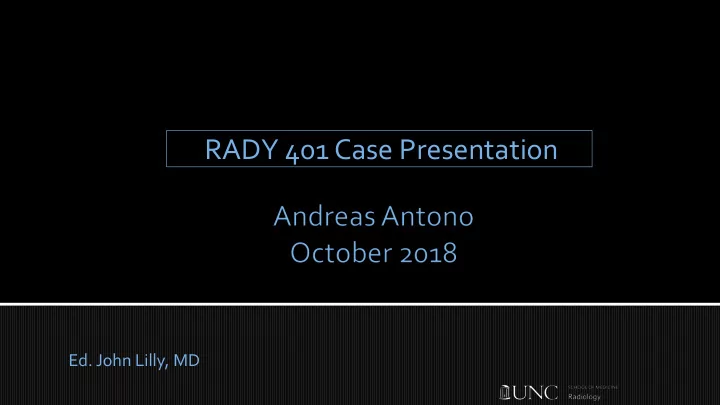

RADY 401 Case Presentation Ed. John Lilly, MD
Ms. O is a 24 yo G0 who presented as a transfer from infertility clinic with nausea, vomiting, and abdominal pain, in the setting of IVF oocyte retrieval earlier that day. Her cramping began the night before and worsened after the procedure. The nausea and vomiting began after the procedure, but worsened throughout the day. She became concerned when these symptoms did not improve with anti-emetics. She has not been able to tolerate PO. VS: HR 102, otherwise wnl Exam: NAD, tenderness to palpation in bilateral lower quadrants, +guarding. No rigidity or rebound. No palpable adnexal masses bilaterally Labs: UPT negative
Differential for woman with acute pelvic pain, nausea, vomiting Ovarian torsion Appendicitis Ruptured ovarian cyst Ectopic pregnancy Tubo-ovarian abscess
Transvaginal Ultrasound with color & spectral Doppler
OVARIES: The ovaries were seen well transvaginally. Bilateral enlarged ovaries with multiple small cystic areas were seen within both ovaries compatible with follicles. And ovaries are adjacent to each other at the midline. Arterial and venous flow was seen in both ovaries with color and spectral doppler although color and spectral waveforms on the right side demonstrated less prominent arterial flow.
Left Ovary: TVUS of left ovary with color Doppler: you can see anechoic regions in both ovaries representing follicles. Waveform shows nice arterial flow
Right ovary: TVUS of right ovary with color Doppler: you can see anechoic regions in both ovaries representing follicles. Waveform shows less prominent arterial flow
Bilaterally enlarged ovaries with multiple follicles, likely due to ovarian hyperstimulation syndrome. Color and spectral waveforms on the right side demonstrated less prominent arterial flow compared to the left side and this could be due to technical reasons although intermittent or incomplete torsion cannot be excluded. Clinical correlation is recommended.
Despite the TVUS findings, the patient’s clinical picture was not concerning for ovarian torsion that required surgical management. Abdominal pain/discomfort could be explained by oocyte retrieval procedure. Patient was kept for observation overnight due to nausea and no PO intake Patient discharged HD#2 after improvement of Sx.
Pelvic Pain (90%) Adnexal Mass (86-95%) Nausea and vomiting (47-70%) Fever (2-20%) Abnormal genital tract bleeding
History & Exam Labs: Serum ß-hCG, Hct, WBC, chemistries Imaging: Ultrasound is appropriate (no radiation, permits real- time imaging with documentation of vascular flow to the ovary (or lack thereof) with Doppler. MRI/CT are more expensive and not much better Diagnosis is clinical → can only be confirmed in laparoscopy
https://www.acr.org/Clinical-Resources/ACR-Appropriateness- Criteria
TVUS: A: R TVUS Doppler → enlarged, edematous right ovary with no flow B: L TVUS Doppler → Normal size with normal flow
A 2002 prospective study 3 conducted at a single institution in Israel looked at 65 women prior to laparoscopy for suspected adnexal torsion. Of the 65 patients undergoing laparoscopy, 15 patients (23%) had ovarian torsion diagnosed during the procedure. All 15 patients with torsion had abnormal flow detected in their spectral Doppler studies – 10 cases had no arterial or venous flow in the affected ovary, while 5 case had arterial flow without venous flow. 50 out of 65 women were not found to have torsion during laparoscopy. 49/50 women without diagnosed torsion had arterial and venous flow detected on spectral Doppler. From these values, the authors calculated that color and spectral Doppler examinations had a sensitivity of 100% and a specificity of 98% for detecting ovarian torsion.
2000 retrospective study 4 looked at 21 patients who had ovarian torsion confirmed during surgery. Only 10 of these patients had received Doppler sonography prior to surgery. Of the 10 patients, 6 had normal flow detected by the Doppler studies, while 4/10 had decreased or absent flow. The authors concluded that abnormal (decreased or absent) flow to the ovary was highly predictive of adnexal torsion .
Laufer MR. (2018). Ovarian and fallopian tube torsion. In: UpToDate, 1. Post, TW (Ed), UpToDate, Waltham, MA, 2018. Priyadarshani R, Atri M, Harris R et al. (2015). ACR Appropriateness 2. Criteria Acute Pelvic Pain in the Reproductive Age Group. Available at https://acsearch.acr.org/docs/69503/Narrative/. American College of Radiology. Accessed Oct 11, 2018. Ben-Ami M, PerlitzY, Haddad S. (2002). The effectiveness of spectral 3. and color Doppler in predicting ovarian torsion: a prospective study. European Journal of Obstetrics & Gynecology and Reproductive Biology 104:64-66. Pena JE, Ufberg D, Cooney N, Denis AL. (2000). Usefulness of Doppler 4. sonography in the diagnosis of ovarian torsion.
Recommend
More recommend